Identifying High-Risk Patients to Reduce Thirty-Day Readmissions to Hospitals
Post-acute/long-term care facilities are integral members of the con- tinuum of care and play an active role in decreasing 30-day hospital readmis- sions, thereby reducing avoidable medical costs. The Centers for Medicare and Medicaid Services (CMS) has identi ed several high-risk diagnoses commonly leading to readmissions. This article identi es additional classes of patients with speci c complex medical problems at high risk for re-hospitalization. We offer interventions from our facility, implemented in an attempt to minimize the risk of readmission for these patients. Increased focus on these complex patients may be the next frontier in addressing 30-day readmission rates.
Key words: 30-day readmissions, accountable care organizations, medically complex patients, high-risk patients, post-acute/long-term care
Creating strategies to improve 30-day readmission rates to hospitals is essential for all post-acute care providers. Up to 20% of Medicare beneficiaries discharged from a hospital will be readmitted within 1 month,1 costing the US health care system $17.6 billion yearly.2 Preventing readmissions saves money, and it is estimated that two-thirds to three-quarters of the readmissions, accounting for $12 billion in costs, are avoidable.3,4 More importantly, fewer readmissions means improved quality of care and quality of life.1
As part of the Patient Protection and Affordable Care Act of 2010, accountable care organizations (ACOs) have been set up in an attempt to improve health care quality and lower costs through financial incentives.5 Skilled nursing facilities (SNFs) are active partners in this endeavor, and hospitals realize that post-acute facilities and SNFs must be fully invested in the process if they are to save money for the Centers for Medicare and Medicaid Services (CMS). Penalties for readmissions due to myocardial infarctions, heart failure, and pneumonia have been established beginning in 2013, and since 2015 for total knee and hip arthroplasties and chronic obstructive pulmonary disease (COPD). In 2015, up to 3% of a hospital’s total Medicare reimbursements were at risk;6 thus, much effort has been focused on preventing these 30-day readmissions while maintaining and improving quality of care.7
As a member of one of the Pioneer ACOs, our facility has made great strides in decreasing our readmission rate by targeting high-risk diagnoses and using an interdisciplinary approach to manage patients with these diagnoses.
Identifying High-Risk Patients
The setting for this study was a 720-bed post-acute and long-term care institution located in an urban, inner city area. We are a teaching facility and have both geriatric fellows and medical students rotating through. The socioeconomic and medical complexity of our patient population is not unusual for an inner-city facility and contributes to our readmission rate. It is acknowledged that maintaining acceptable readmission rates for minorities treated at inner-city medical centers, especially those serving as safety nets or those that are large teaching hospitals, is especially difficult. However, it is necessary for post-acute facilities to do everything possible to prevent potentially avoidable readmissions.7,8 Therefore, a multifaceted, interdisciplinary approach is required.
Every morning, using the Interventions to Reduce Acute Transfers (INTERACT) readmission tool,9 we review the readmissions from the previous 24 hours to see if patterns emerge. We evaluate every 30-day readmission to look for the root cause in an attempt to decrease the risk of readmission for similar future cases that may be potentially avoidable. This information is reviewed with our interdisciplinary team, the specific attending physicians who were caring for the patient, and members of the Skilled Nursing Facility Collaborative at the coordinating hospital when appropriate. Admitting ~100 post-acute patients per month, we have had the opportunity to review more than 500 thirty-day readmissions over the 3-year time period since we have been collecting this data in 2012. Our goal has been to identify avoidable repeated mistakes, to educate ourselves as to their causes, and to prevent them from reoccurring.
Rehospitalizations occurring within 7 days are thought to be more under the hospital’s control and more preventable than later ones;10 thus, these statistics are reviewed separately with our hospital partner. It is certainly possible that high-risk patients remaining in the hospital longer would lead to a lower readmission rate once discharged. However, because hospital lengths of stay and diagnosis-related group (DRG) reimbursement issues encourage early post-acute care, it is necessary for post-acute facilities to remain vigilant about this issue.
In an attempt to further reduce 30-day hospital recidivism, we have identified specific patterns and types of patients who are at particularly high risk. The types of patients identified by our root cause analysis as highly likely to return to the hospital within 30 days of their arrival to our facility have complex health care needs. The categories of patients most resistant to interventions, and where future focus must be directed, include: (1) dialysis patients, especially for those patients new to hemodialysis; (2) patients requiring bilevel positive airway pressure (BiPAP), especially for those patients with a history of respiratory failure and intubation; (3) patients with peripheral vascular disease (PVD), especially for those patients with vascular ulcers or recent vascular interventions; (4) patients whose goals of care differ from prognosis, especially for those patients without advance directives; (5) patients with complicated abdominal surgery, especially for those patients with percutaneous drains; and (6) patients on broad-spectrum antibiotics, especially for those with fever or leukocytosis upon admission.
Other patients deemed “hospital-dependent” are those transiently compensated in the hospital and are often comfortable and have an acceptable quality of life while there. However, they often have multiple chronic conditions and have minimal physiological reserve to compensate for acute stress or injury.11 Heart failure and COPD feature prominently in cases that fit this description for our facility and have already been identified as high risk by CMS. Anxiety compounds these cases in many of these readmissions, so all patients subject to dyspnea are offered psychological counseling and are invited to participate in our pulmonary support group.
Staff Training
After identifying these groups of high-risk patients, our first step is to ensure all levels of staff are educated about our new initiative and sensitized to the issues surrounding the care of these residents. The medical and nursing staffs are informed that a high-risk patient has been admitted to their service, and these residents are discussed daily for the first 2 weeks at the interdisciplinary morning reports, regardless of the patient’s perceived acuity. All levels of caregivers are sensitized to the subtle changes that may be harbingers of deterioration. Care pathways, with individualized plans of care, are followed when appropriate.
Staff play a vital role in issues identified as contributing to 30-day readmissions such as poor transitions between facilities, problems with medication reconciliation, confusion surrounding post-discharge accountability, and follow-up appointments. Much effort has been expended to minimize readmissions as a result of these concerns.1 Specific to the post-acute/long-term care setting, it has been our anecdotal experience that skilled nursing facility medical staff buy-in, emergency room willingness to treat and release/diagnose, and widespread concern regarding medico-legal liability play a role in high readmission rates.
Case Vignette 1 and Case Vignette 2 provide examples of how a successful transition improved the experience for dialysis patients and patients requiring BiPAP, two of the classes identified above as having high risk for readmission. It should be noted that dialysis patients new to hemodialysis and BiPAP users with a history of respiratory failure and intubation are especially at risk.
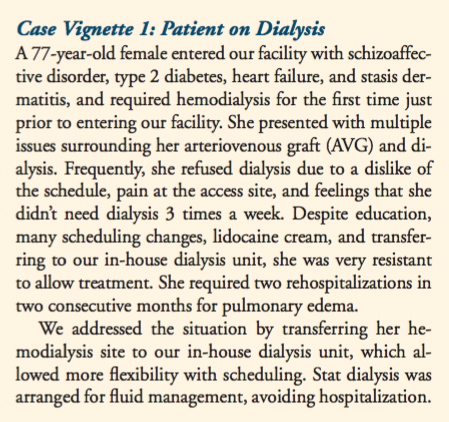
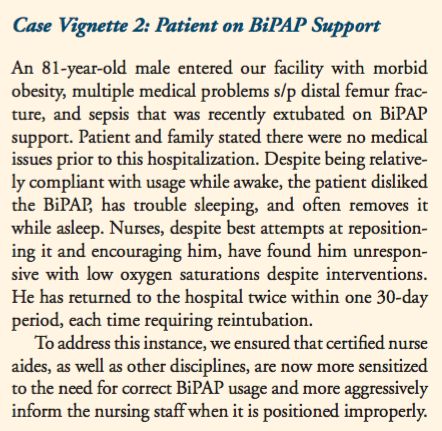
Incorporating the Family
Communication with the family is essential from the very first day. It is important to keep them informed that their loved one is at high risk for readmission, so that they may be more helpful to the process. The family becomes part of the team, alleviating some of the anxiety associated with the transition. Our seriousness about caring for the resident in the facility and not exposing them to the risks of rehospitalization is noted.
Prior to their initial admission, it was observed that acute interventions, rather than palliative approaches were undertaken at the hospital. Thus, residents and health care proxies/designated representatives are more likely to focus on aggressive treatments when real or perceived deterioration occurs. A palliative screening tool has been implemented and, when triggered as appropriate for referral, the resident and family are offered the opportunity for a palliative care consult or hospice. Discussions about goals of care, setting realistic expectations, and discharge planning are initiated before opportunities for misunderstanding or mistrust arise.
Patients with unrealistic outcome goals (especially those with no advance directives; see Case Vignette 3) as well as residents on broad spectrum antibiotics (especially those with fever or leukocytosis upon admission; see Case Vignette 4) are two more of the high-risk classes we have identified; in these cases, family often plays a role.

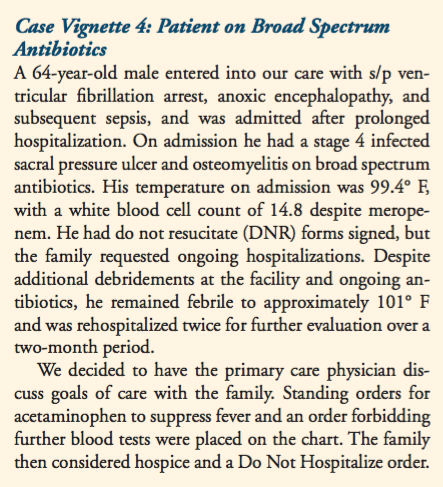
Utilizing Current Physicians As Well As Subspecialists
It is understandable that residents would prefer those health care providers at the hospital who initiated treatment to reevaluate and readjust therapy as warranted, rather than the primary care providers at the post-acute facility whom they have just met. Although residents always have the ability to have a physician of their own choosing, we have identified a group of subspecialists we strongly recommend. They are credentialed in our facility and see patients on site. They trust the care we provide and are aware of our capabilities, making them less likely to recommend rehospitalization. When sending patients to subspecialists less familiar with the facility, we inform the physician, via the transfer sheet, what interventions we can safely provide and what issues we specifically want them to address.
Case Vignette 5 and Case Vignette 6 show the increased flexibility of our staff to work with subspecialists in order to improve patient care experiences. These patients demonstrate two more classes of high-risk patients: those with complex abdominal surgery (especially those with percutaneous drains), and patients with peripheral vascular disease (PVD) (especially for those with vascular ulcers or recent vascular interventions).
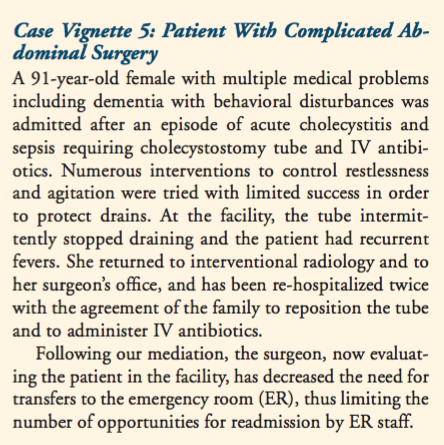
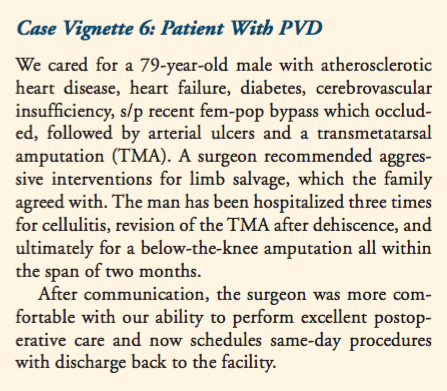
Conclusion
Our internal data reveals that 30-day readmissions have decreased from an initial rate of more than 20% monthly to a rate that is now consistently below 17.5% monthly. Although a full discussion of 30-day recidivism is beyond the scope of our experience, our analysis may alert facilities to other types of residents at high risk for hospital readmission so that they can find means of avoiding these readmissions.
Decreasing the number of potentially avoidable hospital readmissions within 30 days will always take effort. With diligence, even the most acutely ill patients can be maintained out of the hospital whenever their care can be rendered safely. Identifying patients most at risk, and attempting new interventions, is step one in this process.
1. Ouslander JG, Diaz S, Hain D, Tappen R. Frequency and diagnoses associated with 7 and 30-day readmission of skilled nursing facility patients to a nonteaching community hospital. J Am Med Dir Assoc. 2011;12(3):195-203.
2. Graham KL, Wilker EH, Howel MD, Davis RB, Marcantonio ER. Differences between early and late readmissions among patients: a cohort study. Ann Intern Med. 2015;162(11):741-749.
3. Bogaisky M, Dezieck L. Early hospital readmission of nursing home residents and community-dwelling elderly adults discharged from the geriatrics service of an urban teaching hospital: patterns and risk factors. J Am Geriatr Soc. 2015;63(3):548-552.
4. Neuman M, Wirtalla C, Werner RM. Association between skilled nursing facility quality indicators and hospital readmission. JAMA. 2014;312(15):1542-1551.
5. Patient Protection and Affordable Care Act, HR 3590, 11th Cong, (2009-2011).
6. Department of Health and Human Services. Federal Register. 2012;77(170):53258-53750. Government Publishing Office Web site. http://www.gpo.gov/fdsys/pkg/FR-2012-08-31/pdf/2012-19079.pdf. Accessed October 11, 2015.
7. Blumenthal D, Abrams M, Nuzum R. The Affordable Care Act at 5 years. N Engl J Med. 2015;372(25):2451-2458.
8. Joynt KE, Orav EJ, Jha AK. Thirty-day readmission rates for Medicare beneficiaries by race and site of care. JAMA. 2011;305(7):675-681.
9. Ouslander JG, Bonner A, Herndon L, Shutes J. The Interventions to Reduce Acute Care Transfers (INTERACT) quality improvement program: an overview for medical directors and primary care clinicians in long term care. J Am Med Dir Assoc. 2014;15(3):162-170.
10. Joynt KE, Jha AK. Thirty-day readmissions-truth and consequences. N Engl J Med. 2012;366(15):1366-1369.
11. Reuben DB, Tinetti ME. The hospital-dependent patient. N Engl J Med. 2014;370(8):694-697.









